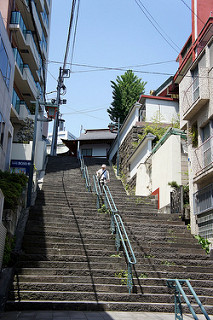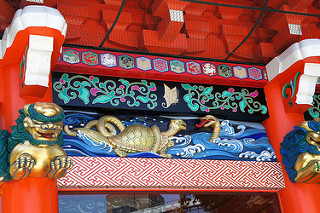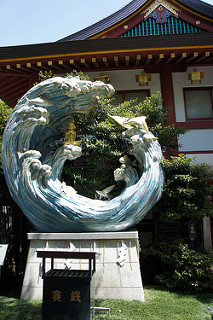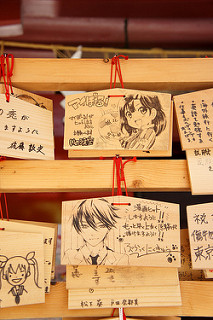I recently read Marcus Jansen’s history of modern Japan and learned that Kanda used to be a mountain, but it was levelled by Ieyasu in order to provide the earth needed to infill Tokyo Bay to create the modern port. We’ve wandered around Kanda and Jimbocho a couple of times on previous visits to Tokyo, and in 2014 our Akihabara apartment was a short walk from Kanda Myojin. The hill that the shrine stands on is still pretty steep.
We visited the shrine on a sunny Sunday during Golden Week. Before we headed up the steps in the photo above, we watched two lads race each other to the top. We walked up after them, and I think we were more out of breath when we got to the top than they were!
Kanda Shrine started its existence in the Otemachi area of Tokyo. It was originally built in 730AD, but ended up in the path of Ieyasu’s planned expansion of Edo Castle. So, in 1603, the shrine was moved to the Kanda ward. It moved again 13 years later to the top of the hill where it still resides. The current structures on the site aren’t original. It suffered extensive fire damage in the aftermath of the Great Kanto Earthquake and was reconstructed in 1934.
I thought the shrine was beautiful, with its bright vermillion woodwork and its lion dogs, nestling on the hilltop amidst the urban sprawl.
The frieze pictured above is on the Zuishin Mon, the copper-roofed main gate to the shrine. It depicts a blue dragon and a black turtle-snake, which are two of the four Shijin (Taoist gods) alongside the red phoenix and white tiger.
The shrine is home to three kami – Daikokuten and Ebisu, who are both members of the 7 Lucky Gods crew and considered to be particularly lucky for business people, and Taira no Masakado, a Heian-era samurai who led a rebellion against the government in Kyoto and whose head was brought to Tokyo. Local residents in the Shibaraki area, the destination for Masakado’s head, respected his defiance so much that they enshrined him at Kanda Myojin.
There is an incredible statue of Ebisu at the shrine.
Instead of Ebisu being depicted in his usual form as a fisherman, this statue refers to Ebisu’s childhood. Ebisu was the son of the gods Izanagi and Izanami, who gave birth to the many islands that make up Japan. He was born without bones and, unable to walk, he was put into a boat of reeds and cast adrift on the sea. The statue shows Ebisu in his boat riding on the crest of a wave, surrounded by turtles and fish. He washed ashore in Hokkaido and was adopted by an Ainu fisherman. His bones grew and, aged three years old, he became a god. I didn’t know that story before I visited Kanda Myojin.
The shrine, perhaps because of its proximity to Akihabara, is also associated with IT and with manga. We saw a couple of lucky charms in sticker form on sale that you could affix to the back of your tech to ward off system failures, data loss and identity theft.
More spectacularly, though, the shrine is full of ema plaques decorated with manga.
In 2012, an anime/manga/idol project started, called Love Live! which is set around Akihabara and features Kanda Myojin as one of the key locations. It’s quite something to walk through the stands of ema and see the creativity of visitors to the shrine. Some of the ema are pre-printed, but the vast majority look hand drawn and coloured. It was one of my favourite things about the shrine.
My most favourite thing, though, was the miniature pony.
Because we love Parks and Recreation, we named this pony L’il Sebastian. It turns out she’s a girl pony called Akari, and she is the shrine’s sacred horse. She’s there to carry the gods if they want a trot out. I expect that Baby Ebisu is fine riding a miniature pony, but I’m concerned about Daikokuten. Let’s not even think about how the severed head of Taira no Masakado gets on the back of a miniature pony. Akari can’t be expected to carry him in a mikoshi, surely?
I bet she takes part in the Kanda Matsuri every May, though. We were in the wrong year for the big festival and also too early in the month. The big festival, which is one of the biggest shrine festivals in Japan, takes place in odd years, with a smaller festival in the even years. In the big festival, 100 mikoshi and 300 people parade through the streets of Tokyo, around Kanda, Nihonbashi, Otemachi, and Marunouchi.
I would love to see it. Maybe one day!










